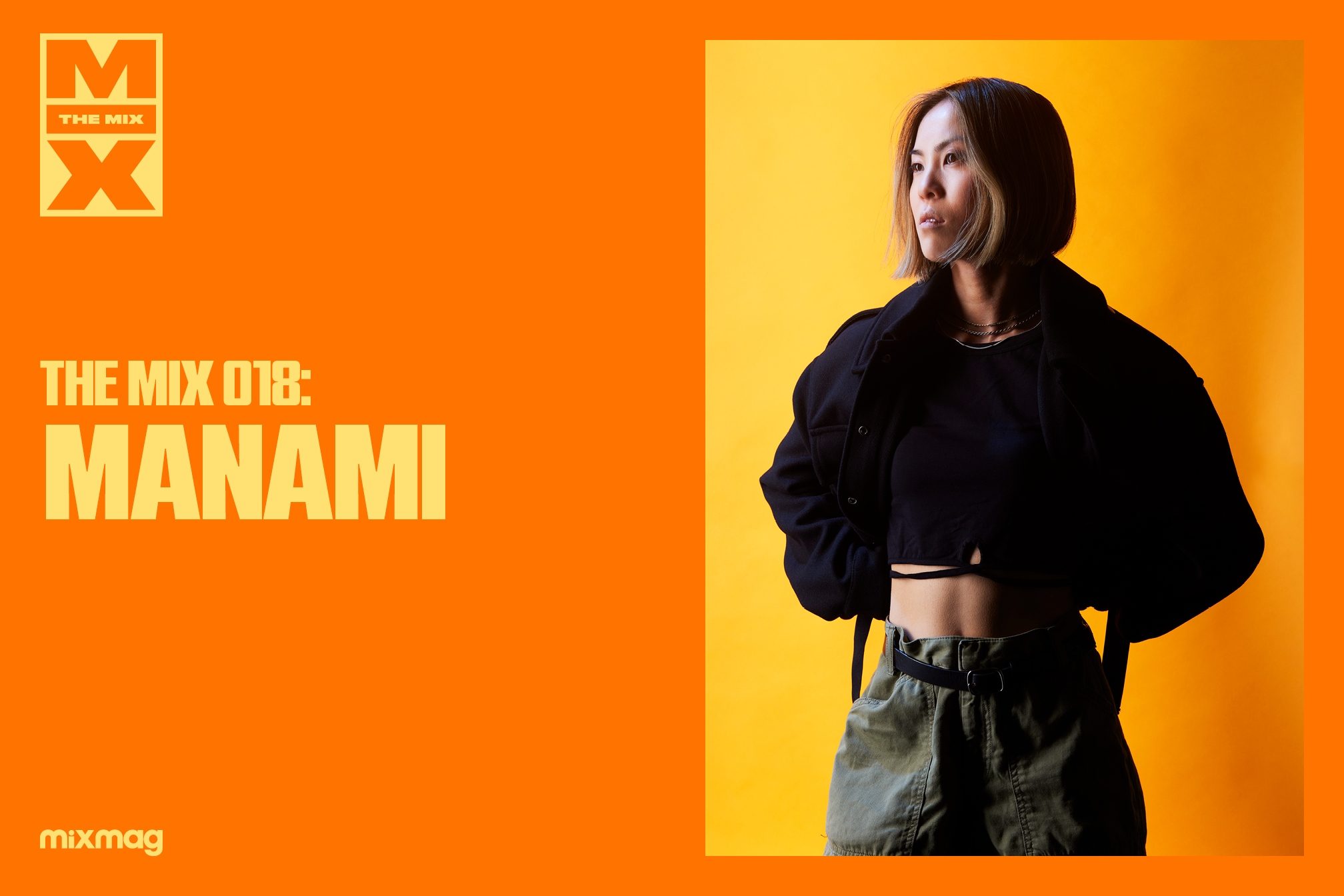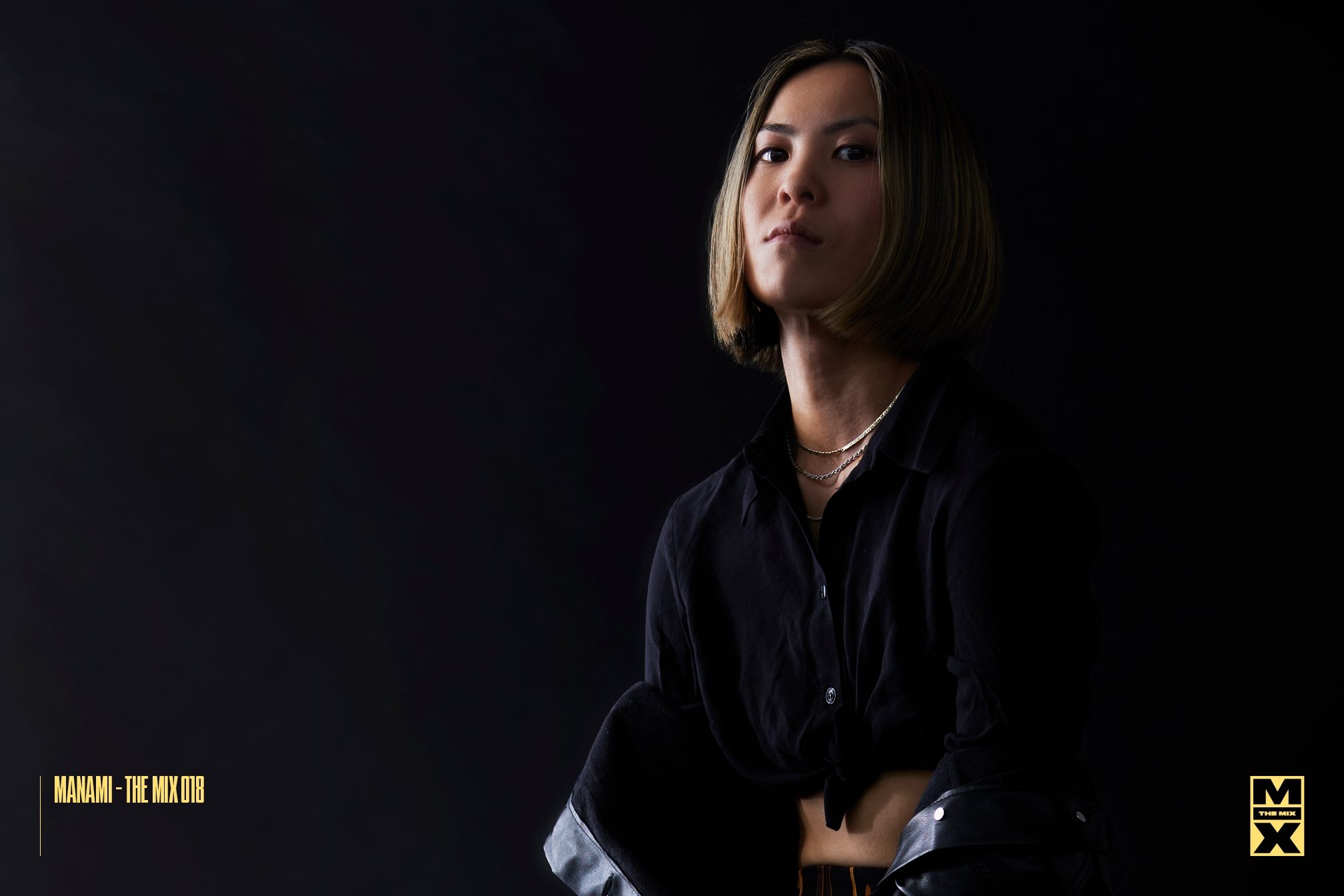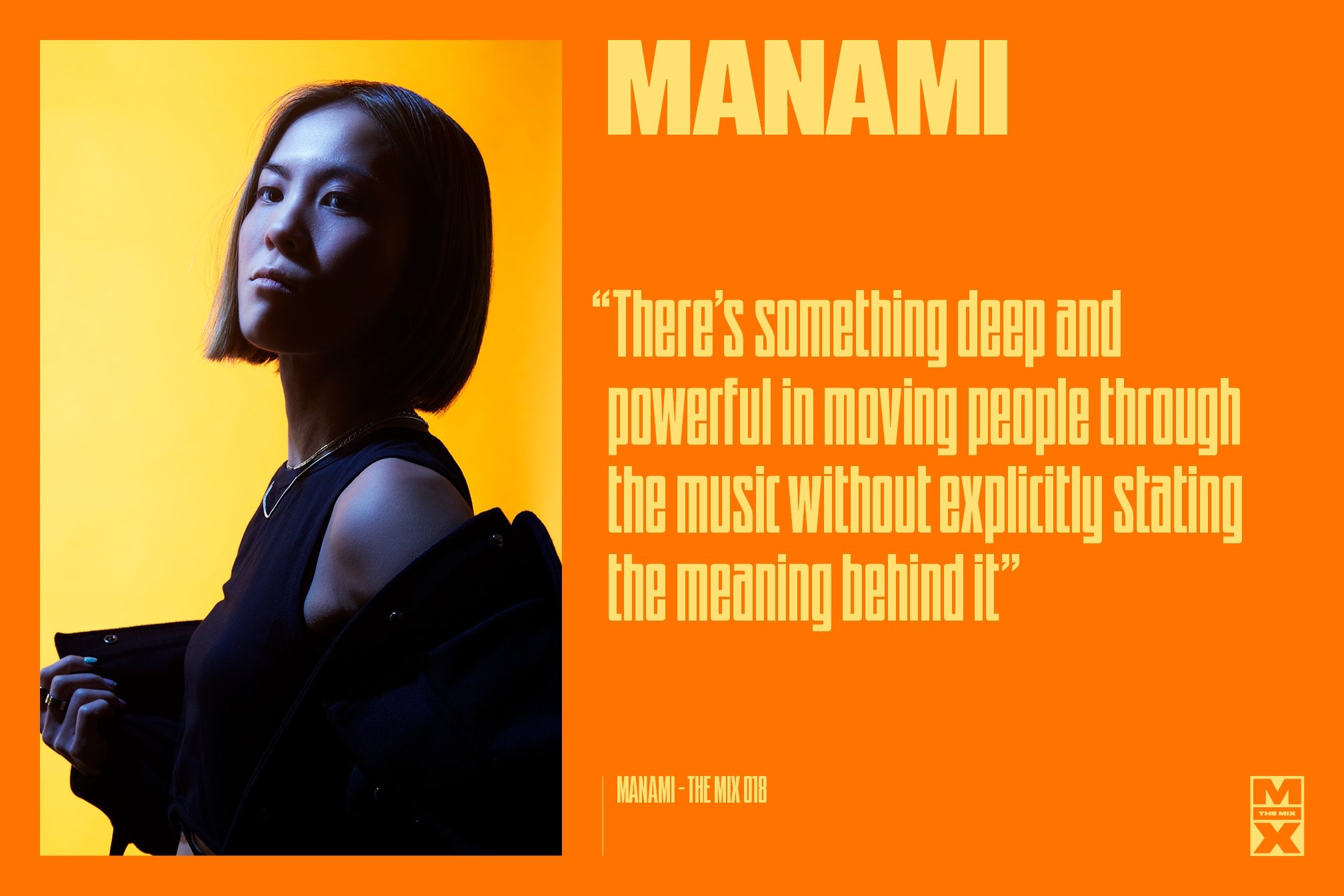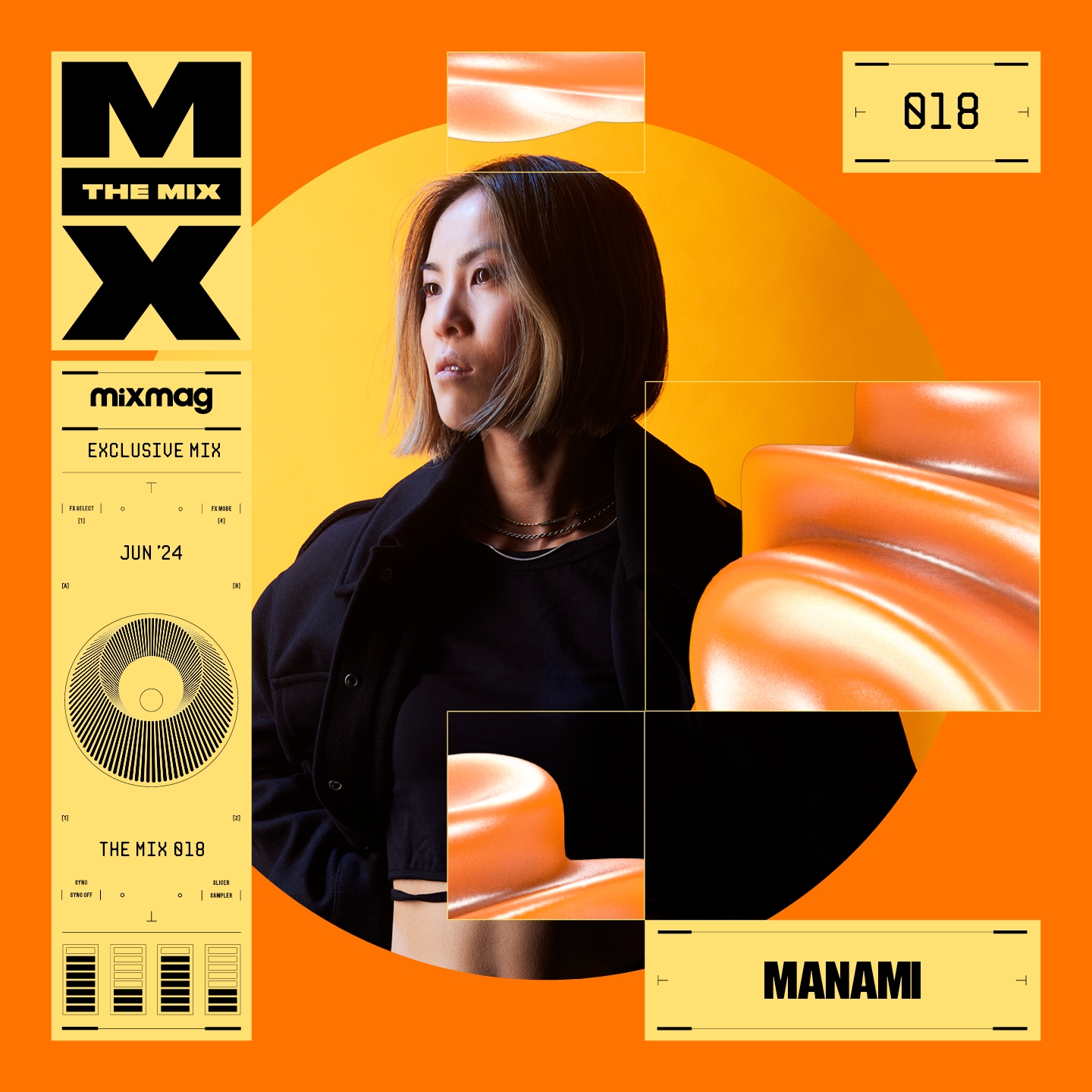 Music
Music
The Mix 018: Manami
Moving away from her early inspirations of Chicago house and disco, Manami is now dedicating her sound to the dark and murky depths of bass. The Tokyo-born, London-based DJ and producer shares a mix that represents where she's at as an artist, and speaks to Jasmine Kent-Smith about self-confidence, mentoring, and telling stories authentically
Ask Manami about her first solo DJ gig and she’ll open the hatch and take you down to the Bunker in Bristol.
In September 2016, Manami was a second-year psychology student reconciling a classical background with a burgeoning love for electronic music and culture. She arrived at the Monday night show – a room two, dodgy decks, student night situation – armed with CDs, a notebook, and crossed fingers. She walked away with a spark that’s kept her going ever since.
Manami’s career has skyrocketed in the years following that debut gig. She’s become a familiar face at notable global gatherings including Love International, Glastonbury’s Silver Hayes, Melbourne’s Strawberry Fields, and Berlin Atonal. There have been support slots for household names like Peggy Gou, Orbital and Bicep, during which she’s whipped up choice cocktails of deep and progressive house, techno, electro, acid and breaks with finesse. She may call London home these days, but Bristol’s never far from her mind: her Better Days radio show (which shares its name with her party) is hosted on Noods Radio, while she can also be found pulling musical all-nighters at hotspots like the Love Inn. A full-circle moment, to some extent, given the hours she spent there locked into the sounds of vital local labels such as Livity Sound.
Her production journey began in earnest a little later, once she decided to commit to a career in music fully. This decision, she recalls, was marked by a PowerPoint presentation-style chat with her family. “That really was the vibe!” Manami laughs. With time and releases, such as her suitably spacey, mind-massaging debut EP ‘Eventide in Orbit’, Manami’s sound has evolved with her. What was once more heavily inspired by formative discoveries like Chicago house and disco, and the melodic flourishes she’d carried over from her piano and violin days, has moved into something darker and more overtly bass-orientated. You can see this reflected in her sets and mixes, including her 2023 trip to The Lab LDN.
Read this next: The Mix 013: Nikki Nair
Recently, Manami has shifted gears, as her latest EP ‘Dreaming Still’ demonstrates. In her own words, the six-track project “depicts an abstract tale of two contrasting worlds” across which she glides between blissful and blistering. There are ambient moments that quiver with life, but there are also entire tracks designed to rattle your ribcage, where Manami picks up the pace and doubles down on the force. The final result feels less contradictory, and more like two sides of the same coin. The emotions behind these tunes are the same, really, it’s just the delivery that’s different.
‘Dreaming Still’ was the inaugural release on Manami’s VMR (Virtual Myths Recordings) label, a platform she’s described as “a new home for telling stories authentically, unbound by genre restraints” where self-expression and fleshed-out narratives are key. Launching a label aligns with Manami’s pursuit of greater creative freedom, and the instinctual, adaptive approach she’s taken since that night at the Bunker. As a DJ, she performs in a dynamic, “live way with looping, vocals, and FX”. But she’s also been developing a new hybrid live set in an effort to deepen her connection with the audience. If you were among the crowd at this year’s GALA Festival – where her parents were also in attendance – you’ll have witnessed the show IRL.
GALA may have been her parents’ first-ever festival, but it wasn’t the first time she’d shared a live music experience with her mum. Growing up in Buckinghamshire (after moving there from just outside Tokyo when Manami was a baby), they’d often attended classical concerts and choir shows together. Manami was honing her musical skills at this point, so she’d sometimes take part in performances. It wasn’t until she landed in Bristol, however, that her eyes were fully opened to the possibilities of electronic music. "I developed my DJing and my musical understanding there, which fast-tracked my understanding of dance music," says Manami, who relocated to London two years ago. If you were wondering, that move has “100 percent” had an impact on her sound, steering it in this amorphous, low-end-favouring direction.
Some aspects of Manami’s work will never change, such as her involvement in community-based education and support initiatives. She works with Saffron, the Bristol-based non-profit and record label, and co-launched the East and Most community event series with her best friends. Both underscore her dedication to mentoring and uplifting underrepresented groups in the industry. Having faced challenges herself, Manami strives to create the inclusive, welcoming environment that she once sought. As she reveals here, too, there’s more on the way when it comes to projects such as these.
For Mixmag’s The Mix series, Manami also delves into her creative process, inspirations, fresh starts and the story behind her new EP and label. Read on and hit play.

How has your 2024 been so far?
It’s been pretty productive. Lots of new and fresh starts, which has felt right.
I saw that you took your parents to GALA a few weeks ago, which you said was their first festival. Can you tell me more about that?
My mum had seen me play in Japan, and that was really special, but my dad hadn’t. [As I said in my Instagram post], my dad fell asleep for the entirety of my set – but he gave me a reason why! I was more nervous for this one as it was the first time I’d played my new stuff – or this newer sound – to my parents. The gig I’d played for my mum [in Japan] was when I was warming up for Peggy Gou. I was playing more prog and house stuff back then. But I got my mum bopping to 160 BPM.
I love that. And I love that you could share that memory with them as well.
It was very special. I feel like I’ve fully got both of their seals of approval now.
Tell me about this new hybrid live set, while we’re on the topic.
I debuted it at Keep Hush last year. I’ve always wanted an extra level of communication and interaction with the crowd – and another layer of creativity to achieve that – so this felt like the natural next step. It’s been a really fun way to experiment and see how much work goes into [a live show] compared to a DJ set. I’ve been seeing what works, what resonates, and which live elements react best with the crowd, for example.
What was your electronic music diet like back in your university days in Bristol? Where were you going? What did you love?
Outside of genres, the thing I connected to the most when it comes to dance music was learning how and why it came out. That was super powerful. As everybody knows, it was born out of a place of love and acceptance. The power of music brings us into a shared experience, which then creates community. [I was] seeing that in the context of the places I was going to.
The styles I started DJing first were disco and Chicago house out of learning about the history. But there were so many nights in Bristol that I’d go to, like Futureboogie and Slix Disco in the late 2010s (I moved in 2015, and I was quite lucky to have landed at that time). Those house and disco parties [were one side of it], but then there were events like Timedance. I queued outside the ticket-on-the-door Ben UFO event at the Island from early in my second year at uni, and I got properly stuck into it. There was also Livity Sound on a Thursday at the Love Inn. Sometimes it would be packed, sometimes there would be hardly anyone in there. But I got to hear this amazing music from a sick label every month.
Read this next: Timedance: A new UK techno sound
Tell me about the DJ society you joined at uni.
I knew I wanted to pick up a new hobby when I got to uni, and I’d already decided I wanted to join [the society] before I’d started. I’d seen someone DJ at a house party when I was 17 and I remember thinking, ‘I want to do that!’. That first year, I was the only female in the society, going to the practice sessions every week. It was an intimidating place. I just remember so vividly the guys all leaning over and playing a bunch of stuff. It wasn’t a welcoming space. But at the time I was starting, Saffron [the Bristol non-profit organisation and record label] had just started as well. That was developing as I was starting to get more into it. Now, the space is so different – in Bristol, anyway – which is amazing to see.
Let’s chat about Saffron, which you’ve been working with for a while now. Why has it been important for you to dedicate time to upskilling projects and initiatives like those offered by Saffron, alongside your music?
There’s an element of [remembering] how I felt as someone starting out, and how I’d had to push through all of those feelings. Back in the DJ society, people would come through for one session and as it wasn’t a nice space, they wouldn’t come back. It was such a shame and it didn’t feel fair that these people didn’t feel like it was for them, as it looked as if it was tailored to males.
These days, I mentor with Saffron; I do the Mix Nights, I do one-on-one tutoring and I also do private sessions for female, femmes, non-binary and trans people. It’s super important to create a welcoming and encouraging space because it’s for everyone, and it’s meant to be enjoyed by everyone because it’s fun. I think anyone can get into DJing because the actual technicality isn’t that difficult, but that’s the beauty of it. Compared to the violin – which I did all the grades for, but I still sounded like shit! – you know, half of it is that it’s supposed to be fun.
What’s been the most rewarding aspect?
Watching confidence build. As a mentor and tutor, half of the role is teaching the technical elements of it and the other half – particularly for women and female-identifying artists – is getting them to believe in themselves, and believe that they can do it.
I want to know about Manami, the artist. How did you get to this sweet spot you’re in today, where you’re taking leaps forward and feeling inspired by what you’re working on?
I was going to say it’s hard to pinpoint, but I suppose it isn’t. Special Request posted a pretty cool thing on Instagram that resonated with me [in terms of] telling other people how to be an artist: just be an artist.
Even though it’s nothing revelatory when it comes to me having these realisations, that’s how it felt at the time [when I was working out] what it means to make art and have the privilege of making art through production. I’d never really considered it like that before. At points, there had been various factors and pressures. I’ve been lucky that I’ve grown up as an artist within the industry, as I’ve been surrounded by a lot of people who’ve been helpful and given advice along the way. But I think almost being thrust into those circles at 19 and 20, I knew nothing at that time. I’d only just discovered this music.
I can relate to growing up within the industry – I was the same age when I joined Mixmag actually. I feel like I was much braver back then.
Totally. You don’t really know what’s going on but you’re just rolling through.
There’s lots of stuff that I got told to do or think about [early on] that didn’t make much much sense to me then – questions like ‘what or who do you want to represent?’ – and there are certain things that have only started to click for me in the last year. I suppose as you get older and experience more of life, you start to realise that you have a lot more to say. As I’ve continued to grow my understanding of my identity and my heritage and those sorts of things – which I hadn’t thought as deeply about growing up – [I’ve been] able to use music as a tool for therapy, in a way, or just expression, which is what it is. Music is self-expression and that’s how we should treat the music-making process.

Before we dig into the EP – which, spoiler, I really enjoyed – in what ways, consciously or subconsciously, have you been reconnecting with your identity? What has that process looked like?
So I started this community event series called East and Most with two of my best friends, Helen and Jasmine. It connects the ESEA (East and Southeast Asian) diaspora through market events, and music events as well. We all had similar experiences of how we personally felt as people of the diaspora when we were growing up. Having grown up in a white, middle-class area, it was something that I didn’t fully appreciate.
We started the community event series when I moved to London – where it’s definitely more diverse. When I got to London, I also started going to other ESEA events, like those by ESEA Music and Eastern Margins. I’d go to panel talks and hear people talk about my experience.
At that time and at that moment, I thought I was the only person feeling like they didn’t want people to ‘see’ their ethnicity almost, because I’d seen how people had treated my parents both explicitly and implicitly. I didn’t want to be treated any differently or looked at differently in my work, or how I presented myself in all parts of my life. Someone on a panel for ESEA Music discussed that same thing of rejecting our Asian-ness growing up in the UK or a Western country. After hearing that, and being able to accept that was how I felt, I can hopefully bring that into a part of my expression and do it in an honest way.
Would you say that this experience forms part of the “introspective recalibration of sound and intent” that inspired the EP?
It’s one of the aspects of it. This idea of being able to present my most authentic self with regard to this music.
‘Dreaming Still’ is whimsical but unsettling, dreamy, sure, but also grounded. What other moods, stories or versions of yourself did you draw from?
My emotions from the time I was creating ‘Dreaming Still’ are very much reflected in the music, let’s just say… Though some of the intentions and meanings behind the EP remain private, I’m stoked that you picked up on the balance. I’ve had feedback that I’ve made some people cry by the end of the EP. There’s something deep and powerful in moving people through the music without explicitly stating the meaning behind it; something intrinsic in the music that people connect with.
You launched your label, VMR (Virtual Myths Recordings), with this release. Why did the timing feel right?
I had gone through a bit of a creative lull just before I started making these tunes. I’d been back-and-forth with other labels and I had these feelings of confusion: did I know what they wanted, did I know what I wanted? I was sick of it at that point.
I’m sure other artists can relate.
If you start feeling confused, you can start to lose confidence. So there was that element of it. But also, I find that some other labels churn out the music a little bit. They put out the music – which you’ve worked super hard on – and they’ll maybe release a single, the rest of the EP, and then it will get forgotten about before and after. I wanted to put more love into the roll-out and the storytelling aspect of it, providing more background to the music and the EP whether explicit or not, to give the tunes the life I feel they deserve. I could have full creative control in that sense, in the roll-out and how it looks and sounds. This was the perfect project to begin that journey with. I’ll be giving that same amount of care and attention to future label releases, hence why the mantra is ‘telling stories authentically’.
What came the easiest with the EP’s creation, and what presented the biggest challenge?
I suppose the easiest [parts] were the first two tracks I wrote: track one [‘Tinted’] and the second single, the hectic jungle-y one [‘Sekai’]. Those were made over four days.
Is that typical of your usual process?
That was an exception. I mean, when it does flow, it does flow – and as every artist does, we all long for that flow to be there. But that was also the time when I was feeling those emotions the strongest. In part, that was what helped me grow my understanding [of this idea that] great music is born out of whatever thing the artist is going through. That hit me in a pretty big way after writing those two tunes. It was very cathartic and very needed for me at the time. Then the most difficult, I think, was just the process of starting the label. Figuring out the logistics has been challenging but extremely rewarding.
Read this next: The Mix 005: SAMO
You've previously said: “When it comes to production, the place I feel most inspired is on the dancefloor itself. On nights out, I always take recordings on my phone. Instead of trying to recreate those sounds, I will try to emulate the feeling they invoked within me” and you went on to discuss that as an environment for creativity. Would you say that still rings true?
100 percent. I try to get creativity from various places. But ultimately, it is still dance music in the end – [at least] for the stuff that I’m predominantly making now. The fifth track on the EP very much took that route. I went to fabric to see dBridge and Verraco play [last year] and I took shit loads of videos that night and was able to make that tune the following day.
Are there any other dancefloors that particularly stand out as inspirational to you?
The first times I went to De School [in Amsterdam]. I’d make trips over from Bristol and get back on the plane after the events had finished. The feelings I felt on those dancefloors have stuck with me.
In general, I try to keep my phone camera on or switch it on as soon as I feel a certain thing. With what I’m writing now, I’m trying to focus on what makes my body move on a dancefloor and instil that into these new tracks. It’s functional dance music but not in a way where I’m trying to write a banger, but it’s the way that’s most intuitive to me on a dancefloor. It’s been an interesting way to make, and setting those kinds of intentions in the studio has helped me let go of things that would cripple me a lot. Thoughts like: ‘My tunes don’t sound as good as so-and-so’. We all do it, and we all fall into those pits. But going into the studio space with this in mind makes me feel like I’m in control and I’ve got this.
That must feel so empowering.
It really does. I was just like, ‘Wow, you can just flip it on its head’. That’s another thing I’ve also been encouraging in the people I’ve been mentoring in production stuff as well. I suppose I can chat a little more about the scheme I’m setting up…
Yes, please.
That's going to be a more production-oriented mentoring scheme for women and ESEA people. I've got Ableton and Pirate helping to get it set up, but I’m going to work with four or five people over six months, have guest mentors in, and then help [the mentees] with the tunes, which they’ll release on the label by the end of it. As we said at the beginning, it’s really important to me to be creating and serving a community as I continue to do this. That's where this whole dance music thing started, and that's where the future is heading. It's important to nurture that.
Let’s end on your mix, what can you tell me about it?
I haven’t put out a mix in a really long time, and this is the first mix under the rebranded sound. I’ve been playing bass-driven music for longer than I’ve been making it, but this is the first mix exclusively [dedicated] to it. It felt amazing; it was so fun to put together.
I wanted to execute a feeling of a loss of control, as if descending into an abyss-like place and being spat out the other side, using club music that explores the sub-realms. Musically, this mix truly represents where I'm at right now, particularly with my DJing.
Where is it best enjoyed?
A house party – but not at an afters! It’s for while the party is still pumping.
'Dreaming Still' is out now, get it here
Jasmine Kent-Smith is a freelance writer, follow her on Twitter

Tracklist:
1. Stones Taro - Sand Testing
2. Burland - Untitled 140
3. Oceantied - Flicker
4. Fetus - LoLo
5. Henry Greenleaf - Come On
6. Manami - Turbulence
7. COIDO - Ritterstep
8. Bodhi - Reformat
9. Goth-Trad - Apes
10. Tony Quattro & Siete Catorce - Qesem Cave
11. Naco - Uuun
12. Akkord - Smoke Circle
13. Numa Crew- Masai Duty
14. Skeptical - Paper House ft DRS
15. Danvers - Sprites
16. Anna Morgan - Armada Stylo
17. GREAZUS - Sophia
18. Manami - Sekai
19. Never Forget & Kuro Kasetto - Acid Atmo 001
20. Kareem El Morr - Rudeboy Dub
21. Verraco - Si idealizame
22. 96 Back - Laco (Metrist Reworm)
23. HomeSick - Angel


